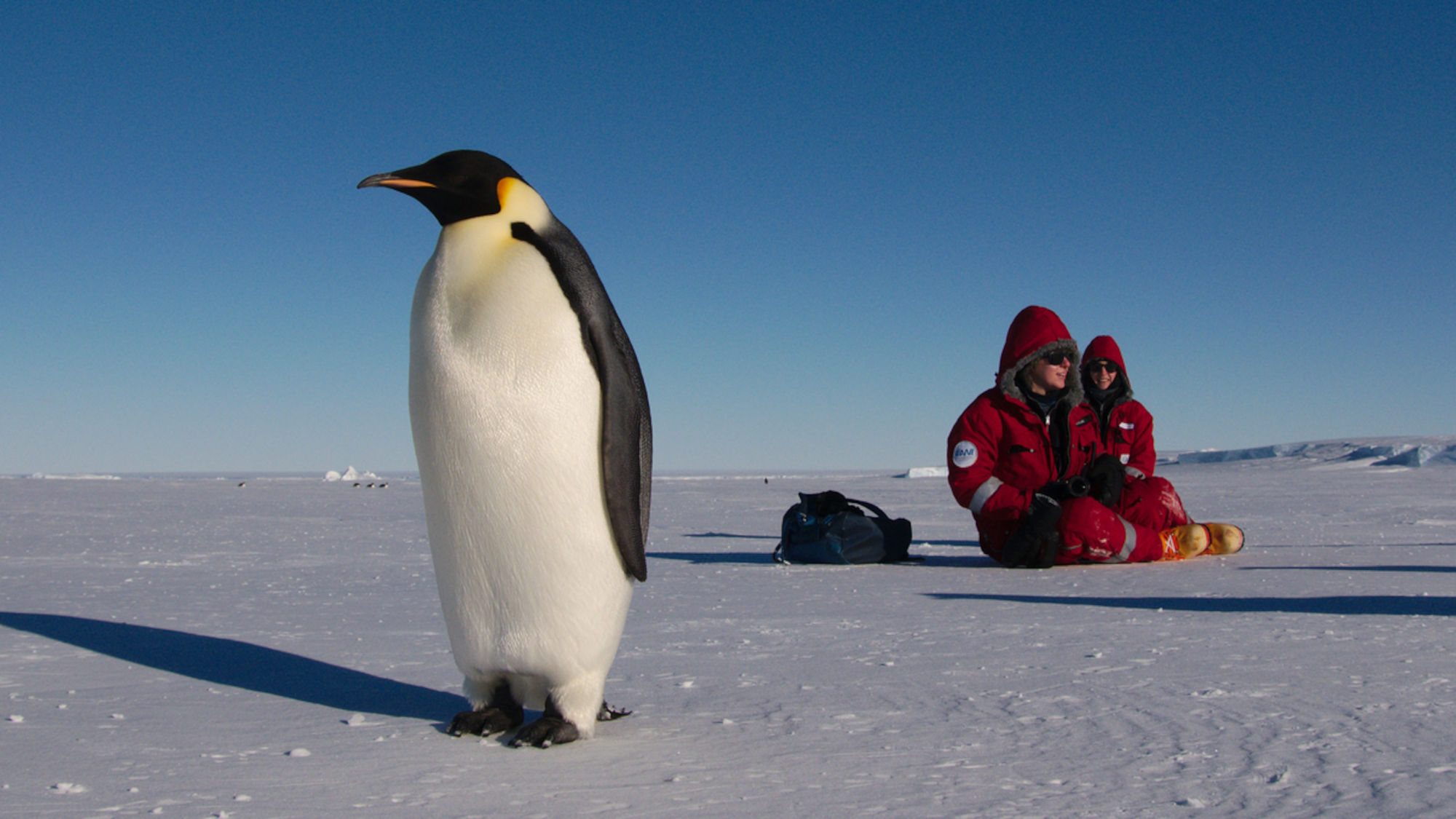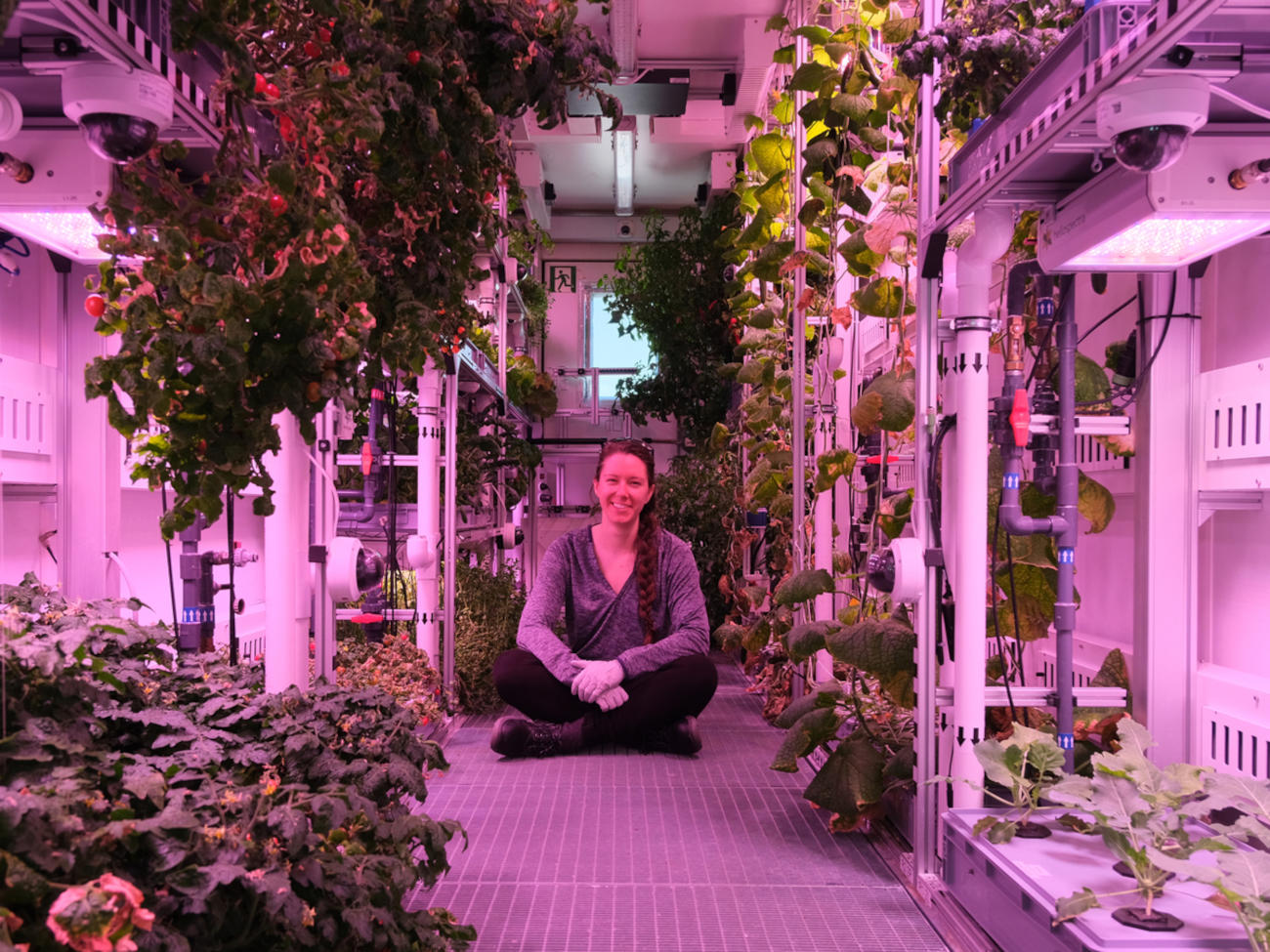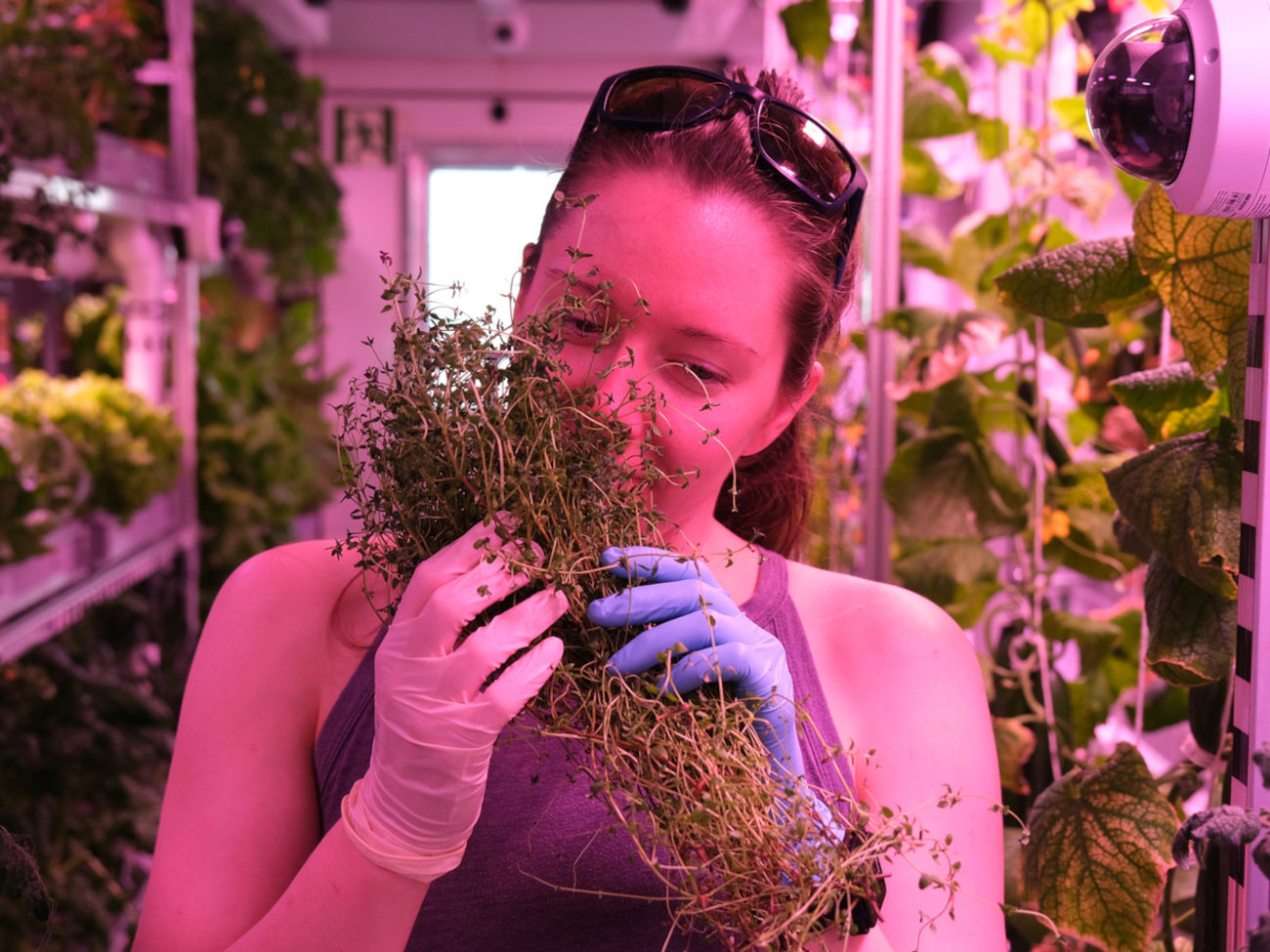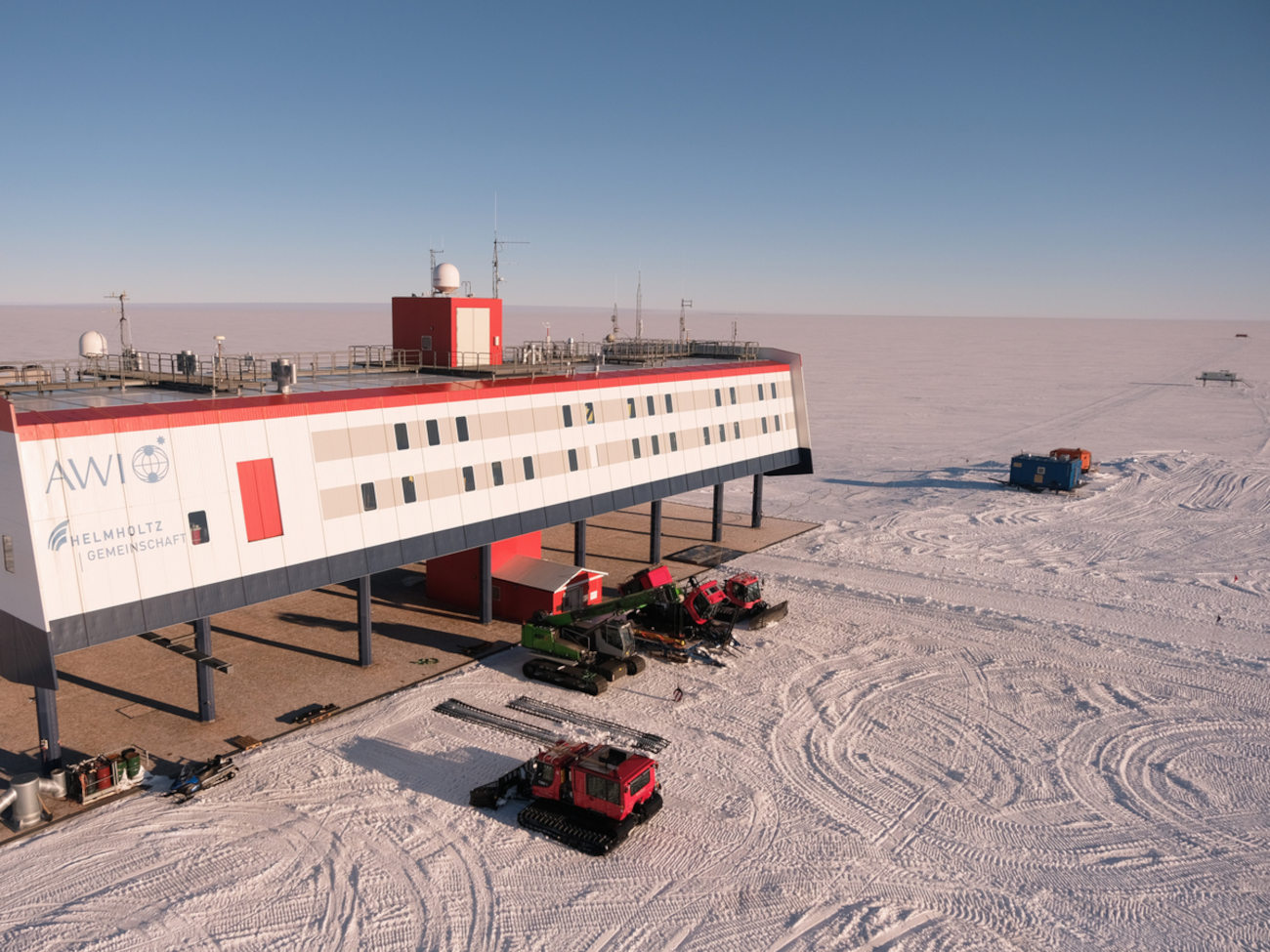
© Lorenz Marten
Plants Would Listen to Harry Potter
Botanist Jess Bunchek lived in Antarctica for 14 months. She talks to up2date. about her adventurous life as a scientist
Spending the winter at the polar ice caps. Spontaneously calling NASA and arranging an internship. Studying German at the same time. Racing over the Bremen dykes on a bicycle. No, the up2date. editorial team did not talk to several different people. Surprisingly, all these things are part of one woman’s life: Jess Bunchek. The versatile US-American scholar is pursuing her PhD at the DLR Institute of Space Systems within the Humans on Mars Initiative at the University of Bremen. On March 14, 2024, she will present her exciting research on “Plant growth in hostile regions” as part of the Science goes Public! series.
One situation in particular illustrates what is special about Jess Bunchek’s attitude towards life: the day of the storm. The then 28-year-old was living with nine other people at Neumayer Station III in the perpetual ice of Antarctica. Her job was growing plants in the EDEN ISS greenhouse container, located on a platform around 400 meters from the station – surrounded by perpetual ice. Jess Bunchek was growing plants so that the crew would have some fresh food during the winter. And to provide the people in this hostile environment with a chance to interact with something that grows. “That’s important for their mental health,” the scientist explains. But EDEN ISS is also about the future. Using Antarctica as an example, the astrobotanist was simulating whether and how it might be possible for people on a space station or on Mars, for example, to provide themselves with fresh, vitamin-rich food.

© Jess Buncheck
For this purpose, she had been growing lettuce, tomatoes, peppers, peas, beans, and other plants and fruit for 14 months – around 100 plants in a 12.5 square meter container. Inside: a pleasant 18 to 23 degrees Celsius, sufficient light, and a regular supply of water and nutrients for good growth. Outside: up to minus 50 degrees Celsius. An environment could hardly be more hostile. This is true even on any ordinary day. Even more so, when a storm with wind speeds of up to 200 kilometers per hour is on the way. “On that day, I had quickly replenished the plants’ nutrient solution at EDEN so that they would hold out well during the storm. I was glad to be back at the safe Neumayer Station. It was already very stormy outside,” Bunchek recalls.
Alert in the Greenhouse
But as soon as she as she sat down, an alert went off: A pump in the greenhouse was no longer working properly. This could pose a threat to the plants. She did not hesitate for long, put her voluminous suit and her thick boots back on, and, accompanied by a colleague, set off for the greenhouse. “It was incredibly strenuous, as it had also become dark in the meantime. We couldn’t use a lamp because of the storm, as the light was incredibly reflective and totally disorientating. We had to work our way forward bit by bit,” remembers the researcher. The two stayed in contact with their colleagues at the station by radio. It was an incredible effort, but one that paid off. The researchers were able to get the pump working again. All the plants survived.
As this story demonstrates, Jess Bunchek is a woman of action. Someone who has the courage to attempt even the seemingly impossible. Growing up near Chicago, even as a child, she knew that there were two things that fascinated her: plants and space. A rather unusual combination, and one that she would not be able to turn into a career. “That’s what I thought anyway. So, I decided to pursue a degree in botany at Purdue University in Indiana, with a minor in German. But my interest in space has always remained.”
Two Passions United
A few years later, she was working on her master’s thesis in agricultural sciences. Incidentally, a NASA documentary was playing on TV. It showed a spacewalk from the ISS. This gave the young researcher an idea. Why not find out whether NASA might have an exciting job for her as a plant researcher? And indeed, she found an internship at the NASA Kennedy Space Center in Florida with the promising name “Veggie Project.” “That was my topic!” Bunchek remembers. Before the TV report was even over, she had already found the right phone number and applied to NASA.

© Linda Ort
Today, some eight years later, she looks back on several years of exciting research work as an astrobotanist. She initially worked as a freelancer on the Veggie Project, and since 2020 has been a visiting researcher at the DLR Institute of Space Systems in Bremen and at the Humans on Mars initiative at the University of Bremen. The latter made it through the first round of the prestigious Excellence Strategy of the German Federal Government and the Länder at the beginning of February 2024 and is now well on its way to hopefully becoming a Cluster of Excellence.
Bunchek’s office in the DLR building in Bremen’s Technology Park perfectly reflects her passions. Naturally, she has several plants, which – unlike in many other offices – are perfectly looked after. On the walls are pictures of Antarctica and an image of an astronaut in a spacesuit. The standard light brown office wall cabinet is barely accessible – several human-sized picture frames are leaning against it. They all show her greatest adventure to date: overwintering in Antarctica, or more precisely, interior views from the EDEN ISS greenhouse. An oasis of life in the middle of the perpetual ice.

© Jess Bunchek
Working on the Perfect Nutrient Solution
The former greenhouse has now been cleared out and is located in a courtyard behind the DLR building in Bremen. The double container returned to Europe on the Polarstern research vessel in spring 2023. However, the return of the container by no means marks the end of the research. In fact, the work is only just beginning. “My PhD dissertation is based on my findings from the Antarctic overwintering. Therefore, I immersed myself deeply in chemistry,” explains the botanist.
Specifically, she is working on nutrient solutions – the substance that supplies plants with everything they need, even in the most hostile regions. “We don’t yet know how the individual components in the nutrient solution behave. Especially after some time has passed. How effective is a nutrient solution if it is already two to three months old?” She expects to have deciphered the exact chemical behavior of the individual components soon. Then she will move on to the second part of her dissertation. This time she is touching on the engineering sciences. “As soon as we know what changes the nutrient solution undergoes over time, we can adapt the technical systems so that it remains usable for a considerably longer period of time,” explains the scientist. For example, it would be possible to equip the next generation of greenhouses with precisely tailored sensors and spraying mechanisms. The ulterior motive: conserving scarce resources. This is not only essential for survival on Mars, but in times of climate change, it will become increasingly important on Earth too.
And what’s the plan for after she submits her PhD dissertation? “I don’t know yet,” says the 31-year-old. She currently feels so happy in Bremen that she can imagine staying here. She likes living in her seven-person shared flat in the Stephaniviertel, and the shared dinners remind her of the unique group feeling in the seclusion of Neumayer Station. She can easily pursue her hobby of road cycling in northern Germany, and for mountaineering and diving – both of which she also enjoys – she regularly travels to more suitable locations.
After our interview, she is going to head to the USA: NASA is hosting a conference at which Jess Bunchek is giving a talk. Before she dashes off to pack her suitcase, I ask her a quick question about the ultimate plant care tip. “What did I do at EDEN to make the plants grow well? Nothing in particular. I talked to them from time to time. But not all the time. Most of the time, a Harry Potter audio book was playing. They seemed to enjoy that. They were about three times the size of the plants in my garden at home when I harvested them,” says the botanist with a smile
Public Talk on March 14
If you would like to meet Jess Bunchek and learn more about her research, you will have the opportunity to do so on Thursday, March 14, 2024. As part of the “Science goes Public!” pub lecture series, she will be speaking about “The Human Element of Growing Plants in the Unlikeliest of Places” at Kono Bar (Am Schwarzen Meer 141, 28205 Bremen) at 8:30 p.m. The talk will be in English. Admission is free of charge. The Science goes Public! series will once again bring numerous entertaining academic talks to the pubs of Bremen and Bremerhaven, from March 14 to April 18, 2024. The program is available on the event series’ website.
Further Information:
Buten-un-Binnen interview with Jess Bunchek after her return from Antarctica (in German only)